Complimentary worldwide shipping on orders over $400 · No import tariffs for most countries
Complimentary worldwide shipping on orders over $400 · No import tariffs for most countries
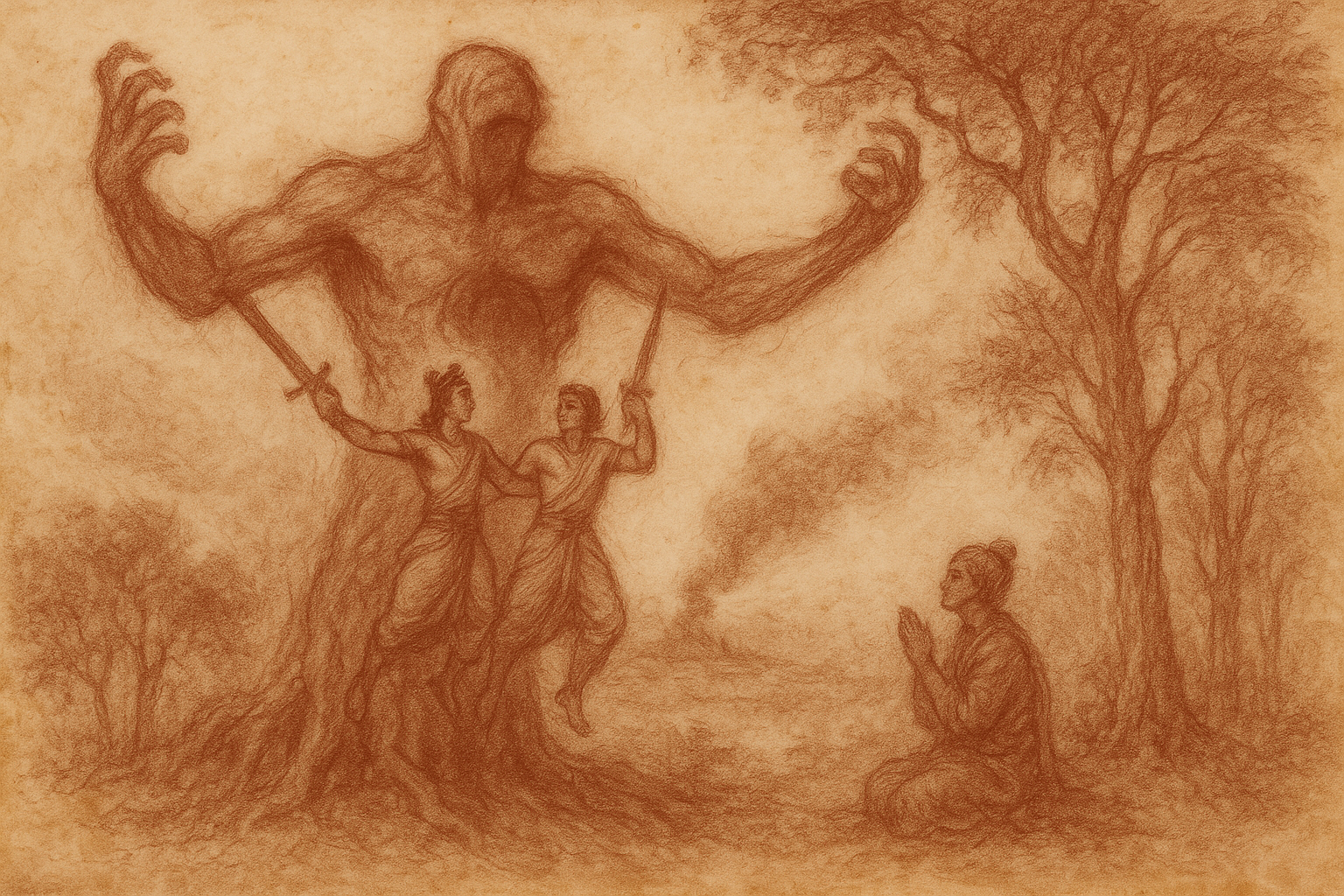
The Killing of Kabandha
4 min read
Sanctuary of Meaning · Journal Article by Lucas Varro
Those who seem monstrous in form
may yet carry the memory of heaven—
and long to be seen.
This morning, beneath a sky veiled in silver mist, we returned to Angkor Wat. I had come to walk once more among the legends—not the distant echoes of fable, but the living memory carved in stone. We followed the path of Rama’s exile through the forest, the long hush of the Aranya Kanda, where grief and divinity walk side by side, and the god-king—barefoot and heartbroken—searches not for battle, but for his beloved.
This is the forest book of the Ramayana, its middle breath. Sita has been taken. Ravana has vanished into the sky. Rama’s cries rise like incense through the trees. The earth itself feels wounded. Every step deepens the sorrow.
And then—out of the undergrowth—a creature. So grotesque that the eye recoils. No head. No neck. A face sunken into the belly, encircled with wiry hair. One vast eye opens from the chest. Below, a cavernous mouth, fang-rimmed and moist. He is Kabandha.
But he is not merely seen. He seizes.
With arms like fallen tree limbs, he snatches Rama and Lakshmana from the ground, raising them like captured prayers. The scene is a fulcrum—suspended between terror and revelation. Two avatars of dharma caught in the grip of what appears to be nightmare.

Rama and Lakshmana Killing Kabandha, Banteay Samre Temple, Angkor, Cambodia.
Here we see the killing of Kabandha, with Rama and Lakshmana brandishing swords to sever the monster’s arms. In this schematic representation the huge and hideous rakshasa Kabandha resembles a demon kala, with decorative vegetal scrolls sprouting from his head.
You can find this carving on the base of a pilaster on the central sanctuary, on the southern side of the western portico, at Banteay Samre Temple.
At Banteay Samré, the sculptors gave this moment to stone. Kabandha’s body unfurls like a vine-choked monster from the forest floor. He is no longer the grotesque of Sanskrit verse, but a Khmer rakshasa—part kala, part vegetal spirit. Curled tendrils sprout from his crown. His body coils like a curse.
Rama and Lakshmana lift their swords with serene ferocity. Their forms are poised, their resolve unwavering. The monster’s doom has already begun. Yet the stone suspends him in a breath before dissolution—a stillness thick with fate.
The relief lies low, near the base of a pilaster on the southern side of the western portico. One must kneel to meet it. The angle of humility feels intentional.
Kabandha falls—but not in silence. He speaks.
I am not what I seem. I was once Danu, a celestial being. I defied Indra and was cursed to wear this form until Rama’s blade severed my arms. I have waited through ages for this moment.
What he receives is not death, but release.

Rama and Lakshmana Killing Kabandha, Angkor Wat Temple, Cambodia.
Here we see the scene depicted on a flat-shaped pediment over the lintel of the southern portico of the northwestern corner pavilion of Angkor Wat. Rama and Lakshmana are suspended from the ground by the long arms of the hideous Kabandha.
You can see a larger version of this image by clicking here ⧉.
Elsewhere, the tale emerges again—in a pediment over the southern lintel of Angkor Wat’s northwestern corner pavilion. Kabandha rises once more, sculpted like a fevered dream erupting from the stone. His grotesque head juts forward, mouth gaping, teeth bared. His arms stretch across the panel like bridges between worlds, lifting Rama and Lakshmana toward his jaws.
The brothers are calm. Their blades raised. One hand grips the knot of hair atop the monster’s scalp. A detail so strangely tender it halts the breath.
On either side, two sages kneel in prayer. Their high chignons and pointed beards suggest they belong to Matanga’s forest hermitage. A tree flowers behind Rama. Another, branching from behind Kabandha’s skull, seems to grow from him—as if the monster were part of the forest’s inner root.
Below, deer graze. The world continues. The forest does not flinch.
In these Khmer carvings, Kabandha does not match Valmiki’s description exactly. His features echo those of Viradha, another demon slain in this forest. Their monstrous forms blur. The stone does not clarify—but the gesture does. Where Rama severs arms, it is Kabandha. Where arrows pierce, it is Viradha. The act becomes the name.
Valmiki composed the Aranya Kanda in perfect symmetry. The forest opens with Viradha and closes with Kabandha. Two monsters. Two falls. But neither is truly a rakshasa. They live alone—banished, twisted, penitent. Viradha was once Tumburu, a celestial minstrel of Kubera, lost to indulgence. Kabandha was Danu, proud and wrathful before Indra’s throne.
Their deformities reflect not merely punishment, but inward transgression. Their redemption comes not through mercy, but through the sword.
And yet the sword, here, is sacred.
Rama does not destroy—he consecrates. The brothers cremate Kabandha. Fire, not vengeance, lifts his spirit free. From ash, he rises radiant and speaks: Go to Sugriva. He will help you find your beloved.
The monster becomes the messenger. Horror becomes the way.
In every forest,
a creature waits to be seen—
not with the eye,
but with the soul.
The reliefs at Banteay Samré and Angkor Wat do not merely depict an episode of myth—they illumine the sacred theatre of transformation. Kabandha’s fall is not a scene of violence but of grace. In the severing of limbs, illusion is stripped away. The monster becomes the mirror.
The sword is a key. The flame is a doorway.
And the grotesque, seen truly, becomes divine.
Rama walks on.
The forest does not judge—it reveals.
Also in Library
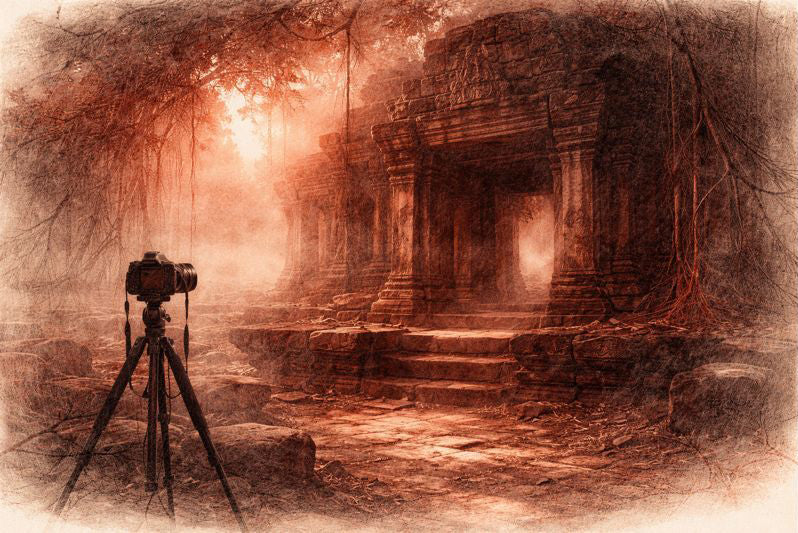
Before the Shutter Falls
3 min read
Before the shutter falls, fear sharpens and doubt measures the cost of waiting. In the quiet hours before dawn, the act of not-yet-beginning becomes a discipline of attention. This essay reflects on patience, restraint, and the quiet mercy that arrives when outcome loosens its hold.
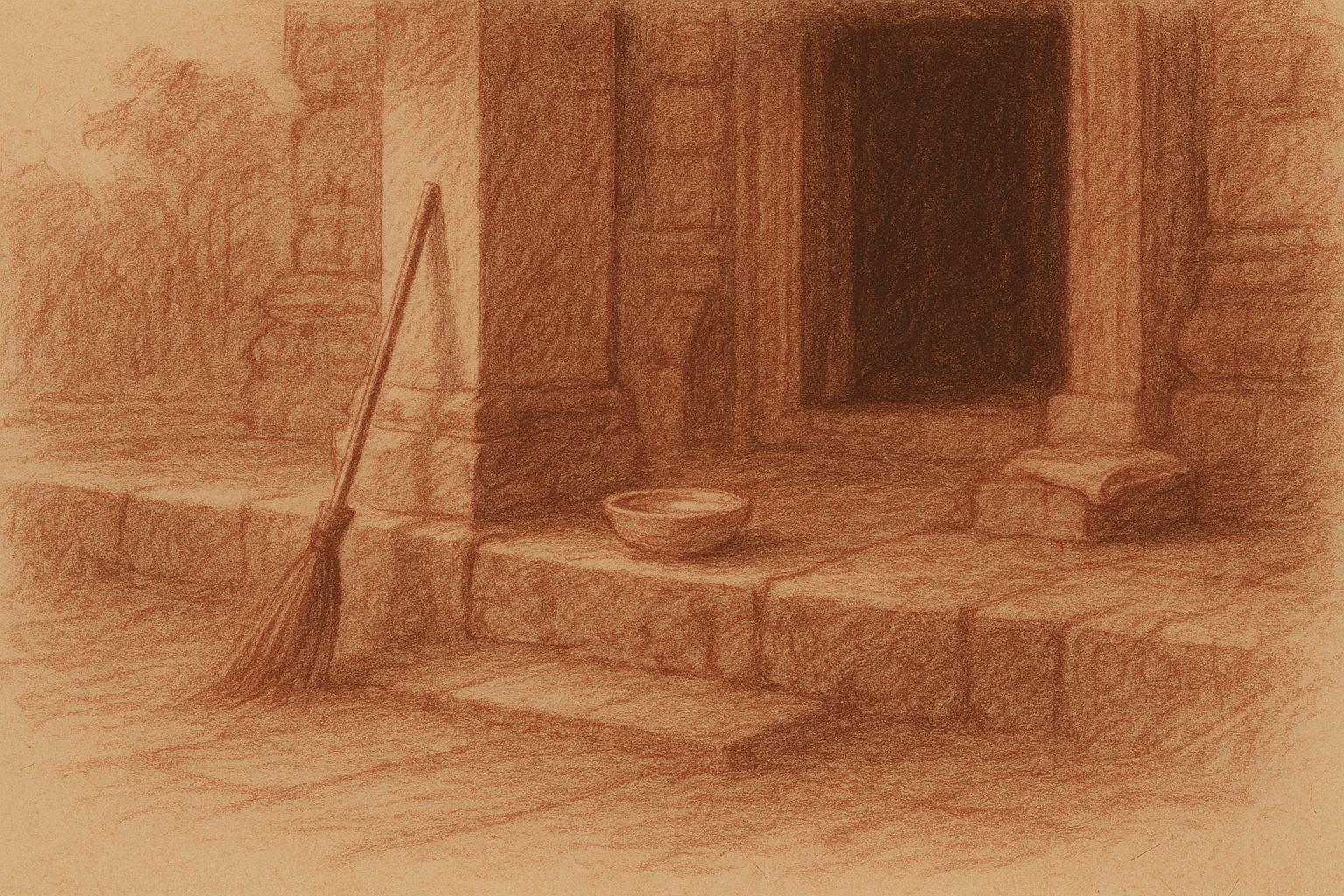
Those Who Keep the Way Open — On the Quiet Guardians of Angkor’s Thresholds
3 min read
Quiet gestures shape the way into Angkor — a swept stone, a refilled bowl, a hand steadying a guardian lion. This essay reflects on the unseen custodians whose daily care keeps the thresholds open, revealing how sacredness endures not through stone alone, but through those who tend its meaning.
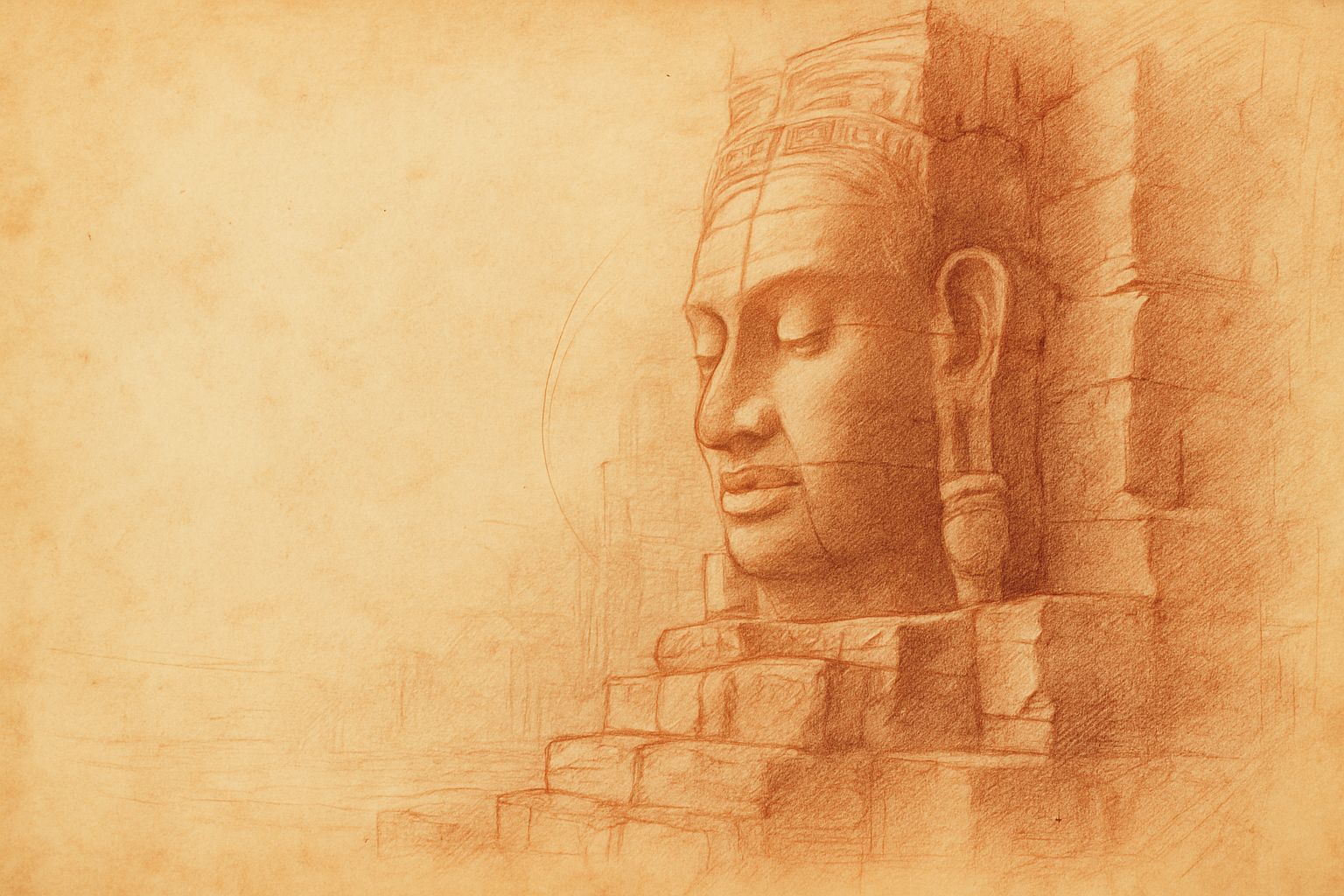
Multiplicity and Mercy — The Face Towers of Jayavarman VII
5 min read
A new vision of kingship rises at the Bayon: serene faces turned to every horizon, shaping a world where authority is expressed as care. Moving through the terraces, one enters a field of steady, compassionate presence — a landscape where stone, light, and time teach through quiet attention.
Join My Studio Journal
Receive occasional letters from my studio in Siem Reap—offering a glimpse into my creative process, early access to new fine art prints, field notes from the temples of Angkor, exhibition announcements, and reflections on beauty, impermanence, and the spirit of place.
No noise. No clutter. Just quiet inspiration, delivered gently.
Subscribe and stay connected to the unfolding story.
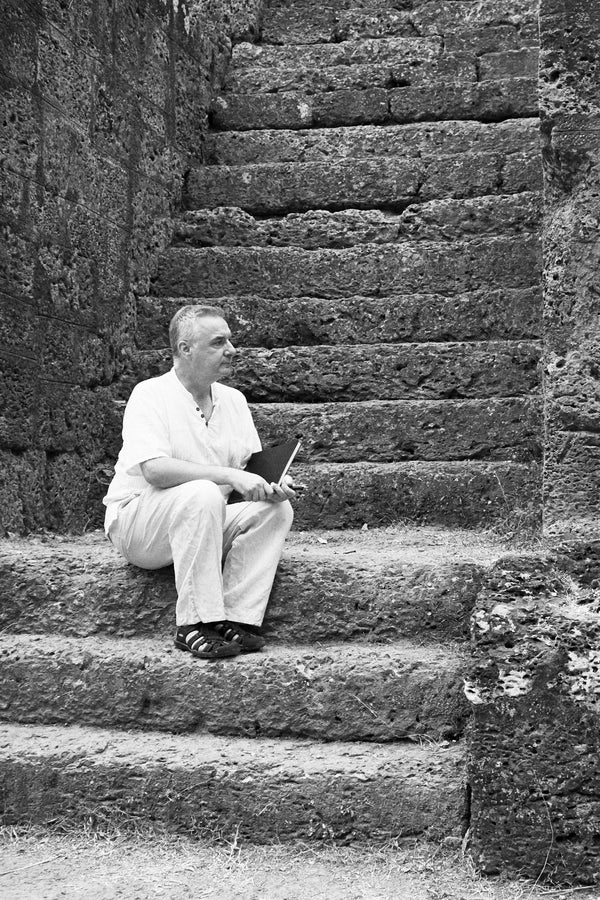
Join My Studio Journal
Receive occasional letters from my studio in Siem Reap—offering a glimpse into my creative process, early access to new fine art prints, field notes from the temples of Angkor, exhibition announcements, and reflections on beauty, impermanence, and the spirit of place.
No noise. No clutter. Just quiet inspiration, delivered gently.
Subscribe and stay connected to the unfolding story.
